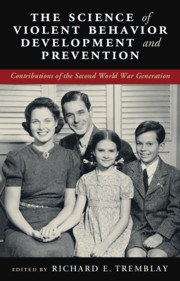 The Science of Violent Behavior Development and Prevention
The Science of Violent Behavior Development and Prevention Published online by Cambridge University Press: 28 January 2021
The first part of the introduction describes the historical context in which the authors of the book were born (World War II) and educated (from the 1950s to the 1970s), as well as the context in which they made their most important scientific contributions (from the 1980s to 2020). The advantages of being at the forefront of the baby boom are highlighted. The second part of the introduction describes the history of research on the development of aggressive and violent behavior, starting with the philosophical contributions of Aristotle, Seneca, Saint Augustine, Erasmus, Hobbes, and Jean-Jacques Rousseau. The chapter goes on to describe the first scientific studies that were initiated in the early part of the 18th century by Adolphe Quetelet and Charles Darwin, as well as the early prevention efforts of Mary Carpenter. The history of the main longitudinal and experimental studies of the 20th century are then presented with a focus on the work of William Healy, Richard C. Cabot, Sheldon and Eleanore Glueck, Joan McCord, and D. J. West.
To save this book to your Kindle, first ensure [email protected] is added to your Approved Personal Document E-mail List under your Personal Document Settings on the Manage Your Content and Devices page of your Amazon account. Then enter the ‘name’ part of your Kindle email address below. Find out more about saving to your Kindle.
Note you can select to save to either the @free.kindle.com or @kindle.com variations. ‘@free.kindle.com’ emails are free but can only be saved to your device when it is connected to wi-fi. ‘@kindle.com’ emails can be delivered even when you are not connected to wi-fi, but note that service fees apply.
Find out more about the Kindle Personal Document Service.
To save content items to your account, please confirm that you agree to abide by our usage policies. If this is the first time you use this feature, you will be asked to authorise Cambridge Core to connect with your account. Find out more about saving content to Dropbox.
To save content items to your account, please confirm that you agree to abide by our usage policies. If this is the first time you use this feature, you will be asked to authorise Cambridge Core to connect with your account. Find out more about saving content to Google Drive.